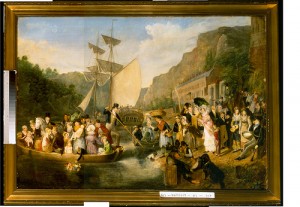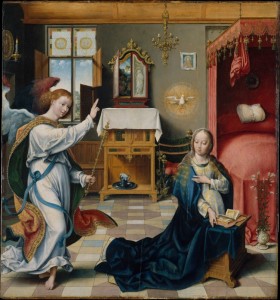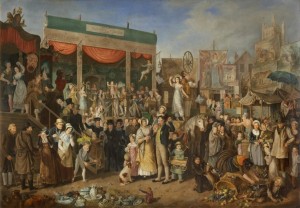When told of Douce’s acquisition of a View of Clifton Ferry with a Holiday Party and Bristol Fair by Rolinda Sharples (1793-1838), his friend George Cumberland wrote that they had been ‘sold at an auction to Mr Douce who knows nothing of painting’.
Shortly afterwards, Douce wrote to Cumberland asking for information about Bristol-based Miss Sharples. Funnily enough, he explained that, in one of the paintings he had bought (the View of Clifton Ferry), a portrait of Cumberland ‘is attempted’:

Rolinda Sharples, Rownham Ferry, 1820-22, Present location unknown © All rights reserved by Bristol Libraries.
What Cumberland considered as a lack of knowledge (and possibly taste) might be in fact an absence of interest in the quality of the works, often eclipsed in Douce’s eyes by their rarity, or by the oddness of their subjects. That Douce could occasionally adhere to established standards of taste is suggested by the singling out of a ‘beautiful painting of the Annunciation of the Virgin’ left to the antiquary Henry Petrie (c. 1772-1842) in his will. Sharples’s pictures were inherited by Isaac D’Israeli, who quickly got rid of them. The remaining paintings from Douce’s collection were bequeathed to Samuel Rush Meyrick (1783-1848) with other ‘miscellaneous curiosities of every description’.
Petrie’s Annunciation was the same painting acquired by Douce for 27 guineas at the Count of Altamira’s sale in 1827. But where is it now? Although both Meyrick and Douce appear as previous owners of The Annunciation by Joos van Cleve in the Metropolitan Museum, the painting is not listed among those included in Meyrick’s ‘Doucean Museum’, described in The Gentleman’s Magazine in 1836. In his copy of the catalogue of the Altamira sale, Douce wrote ‘Certainly by Martin Schoen’ next to lot 36, an Annunciation sold as by Lucas van Leyden. The Annunciation in New York was attributed to Martin Schongauer in late nineteenth-century catalogues -and it could have become Meyrick’s after Petrie’s death in 1842:

Joos van Cleve, The Annunciation, ca. 1525, oil on wood, New York, Metropolitan Museum of Art, The Friedsam Collection, Bequest of Michael Friedsam, 1931. www.metmuseum.org.
Interestingly, in the painting the Virgin Mary seems to be reading an illuminated book of prayers like those collected by Douce; in the background, Moses holding the Tablets of Law is depicted in a hand- coloured woodcut pinned to the wall next to the bed. According to the Met website, A. Hyatt Mayor has identified the print as a lost woodcut attributed to Jacob Cornelisz. van Oostsanen. Douce’s boxes and portfolios are the ideal place to search for lost woodcuts, so I keep Moses in mind while scouring them. For a detailed view, click on the link below and zoom in:

